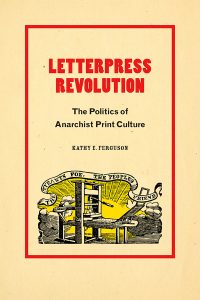In Letterpress Revolution: The Politics of Anarchist Print Culture, Kathy Ferguson considers the ways in which printers bolstered anarchist movements across the US and UK from the late nineteenth century to the 1940s. More than just a means of spreading ideas, Ferguson posits printing, writing and reading as radical, creative acts essential to community-building within anarchist movements, writes Layla Saleh.
Letterpress Revolution: The Politics of Anarchist Print Culture. Kathy Ferguson. Duke University Press. 2023.
Find this book (affiliate link):![]()
 How can reading, writing, and publishing create and sustain radical movements? Kathy Ferguson’s book Letterpress Revolution: The Politics of Anarchist Print Culture broaches this intriguing puzzle. The well-known scholar of political and feminist theory forays into anarchism’s ‘classical age’ from the Paris Commune to the Spanish Revolution (1870s-1940s). This book expands the range of characters from some of her earlier work, for instance on Emma Goldman. In fluid prose, Ferguson offers a fresh historical look at the anarchist movement through a focus on lesser-known figures and their lesser-known labours, including printing and letter-writing. She showcases the swirling interactions between anarchist ‘presses, printers, publications, and reading publics’ (xi). The book thus injects seemingly mundane movement tasks with critical significance, tentatively recreating the relations between people and the simultaneous spread of ideas and practices. Writing and publishing emerge as central to revolutionary praxis and above all, the making of community.
How can reading, writing, and publishing create and sustain radical movements? Kathy Ferguson’s book Letterpress Revolution: The Politics of Anarchist Print Culture broaches this intriguing puzzle. The well-known scholar of political and feminist theory forays into anarchism’s ‘classical age’ from the Paris Commune to the Spanish Revolution (1870s-1940s). This book expands the range of characters from some of her earlier work, for instance on Emma Goldman. In fluid prose, Ferguson offers a fresh historical look at the anarchist movement through a focus on lesser-known figures and their lesser-known labours, including printing and letter-writing. She showcases the swirling interactions between anarchist ‘presses, printers, publications, and reading publics’ (xi). The book thus injects seemingly mundane movement tasks with critical significance, tentatively recreating the relations between people and the simultaneous spread of ideas and practices. Writing and publishing emerge as central to revolutionary praxis and above all, the making of community.
Ferguson organises her investigation of anarchist print culture around three clever interpretations of the word letter: the ‘grapheme’ (think of printers’ blocks); epistolary communications; and ‘a manner of learnedness,’ or anarchist thought. Anarchism is a ‘philosophy and political practice that rejects centralised, hierarchical authority,’ valuing instead egalitarianism, freedom, and voluntary, communal self-governance. Marxist in orientation, anarchism is more radical in practice, declaring ‘states, churches, corporations, patriarchies, and empires’ its sworn enemies. It dovetails with feminism, anticolonialism, civil libertarianism, and even ‘radical ecological thinking’ (2). Following Stefano Harney and Fred Moten, Ferguson suggests anarchism as a rebellious, open-ended ‘undercommons,’ ‘where there is room for transgressive ways’ (135). Its tripartite letters circulate and disseminate creativity, resonance, and collaboration.
Rebuffing a stereotype of anarchists as ‘dirty, ignorant, ugly, and dangerous,’ Ferguson stresses the exorbitant effort, time, creativity, and funds that went into preparing publications.
Chapter One takes up printers and presses, zooming in on anarchists such as Joseph Ishill, William Morris, and Jo Labadie. Ferguson illustrates how the physical labour of letterpress printing intertwines with anarchist ideas and belonging to nurture the movement. In painstaking detail (accompanied by beautiful archival illustrations) she recounts the sights, sounds, and feel of machinery, ink, papers, and engravings that combined intellectual and manual adventurism. The presses are almost another character in her account, indispensable to how ‘anarchy became possible’ (51). Rebuffing a stereotype of anarchists as ‘dirty, ignorant, ugly, and dangerous,’ Ferguson stresses the exorbitant effort, time, creativity, and funds that went into preparing publications that ‘were small, recurrent sites of beauty and learning, prefiguring the world’ they imagined (80-1). Politics need not be roughshod; it can be replete with pleasing sensory stimulation.
Ferguson next opens up the world of anarchism’s international network, showing in Chapter Two how ’anarchists wrote themselves into their politics’ (83-4). She also writes herself into this global circuitry, cataloguing some of her own responses to anarchist letters. These filaments (a term from Bertha Johnson) linked objects, ideas, and people across geography and time, in matters movement and intimate. It is fortunate for Ferguson’s enterprise that anarchism is so well-archived, thanks in large part to the (undervalued) role of women in amassing and curating library collections that include personal letters (113-115). As an ‘external reader,’ she is an ‘active participan[t] in the epistolary process,’ reading letters from multiple vantage points, including the writer’s, the direct recipient’s, and of course her own (108-9). Her reflexivity comes to the fore, as she muses over her own personal connections to archived personalities. In her recounting of Joseph Ishill and Rudolf Rocker’s friendship, Ferguson at once enacts and simulates the ‘external reader’s’ significance and interpretive purchase and (potential) investment in a movement and the people who make it. (For instance: ‘I inadvertently violated the reading room rules by gasping loudly with disbelief’ when Joseph initially refused to print a tribute Rudolf had written to his wife in a January 1956 letter (119). I, too, almost gasped out loud as I read this.)
Ferguson is forthcoming about the interpretive enterprise that can never be exact. It is rather a deliberate assemblage ‘of otherwise dispersed bits and pieces into a new alignment” (112). For anyone working with archives, wondering if we can ever glean intended meanings from their partial representation of erstwhile lives is a common problem. Ferguson demonstrates how to bring the researcher and author into archival reading and historical writing in a way true to the process, at least. Perhaps that is all we can hope to do.
Chapter Three hones in on a third dimension of ‘letters’ as intellectual output and theorising. Ferguson examines the publications Freedom (still running digitally today); Free Society; and Emma Goldman’s Mother Earth. She combs them for tenets of anarchism, highlighting bones of anarchist contention (for instance, about World War I, or gender and sexuality). This examination spans both amateur anarchists’ writings and reader interactions with editors and journal writers. ‘Taking anarchists seriously as people of letters requires rethinking conventional expectations regarding who can make knowledge,’ Ferguson notes (132). This statement has a satisfying feminist, and perhaps decolonising, ring to it. The epistemological stance mirrors academic tilts towards new (even if old) sites and producers of knowledge, as fresh work on women’s international thought and nineteenth-century women philosphers attest.
The movement so eager to lambast imperialism and colonialism was rather neglectful of the racism at home, and of Black resistance cultures and practices.
Also in keeping with the times is Ferguson’s attempt at theoretical innovation. Chapter Four is both critique and rehabilitation of anarchist theory. Reversing popular belief, she insists that anarchism does practice better than theory. The movement so eager to lambast imperialism and colonialism was rather neglectful of the racism at home, and of Black resistance cultures and practices. Her engagement with intersectionality and ‘thing power’ is an attempt to carry anarchist theory over into the contemporary world. Far from ‘flawless,’ the anti-capitalist ‘Food Not Bombs’, the land protection campaign ‘Protect Mauna Kea ‘Ohana’ in Hawaii, and the feminist bookstore movement of the 1970s-1980s are recent examples of anarchist-related activism. The latter two may be emblematic of an ‘anarchist ethos,’ more than explicit ideological adoptions of anarchism itself.
And thus emerges a question of contemporary relevance. Ferguson insists that digital activism is no substitute for face-to-face mobilising when publics and societies everywhere are in desperate need of radicalism. She is right: COVID-19 has certainly taught us the social vacuity of otherwise high-functioning technological connectivity. How, then, can today’s activists construct ‘lively sites’ where people, things, ideas, and discourses create new worlds (20)? To an extent, Ferguson leaves the reader wishing for more specific guidance.
[The text’s] (re)narration of British and American anarchism stands out for the emphasis on community-building forged through reading, writing, and publishing.
As someone who studies protest and revolution in another (more current) time and place (the Arab world), Ferguson’s book resonates less in the specific substance of its topic (although some observer-participants have identified varieties of anarchism in the region’s 2011 revolution, including in Syria). Rather, its (re)narration of British and American anarchism stands out for the emphasis on community-building forged through reading, writing, and publishing. Democratic gains slip away and dreams of freedom sputter over a decade after the Arab revolutions fleetingly mediated in part by Facebook and Twitter. In Tunisia, Syria, and elsewhere across the region, direct action for democracy is aching for creative reinvention. Perhaps the fast-paced immediacy of social media can never rival the mutable durability of words in print, and the sociality surrounding them. But to stop there would be to read this book as melancholy nostalgia, rather than inspiration. Ferguson instead challenges us to ask: how can we better write ‘prefigurative politics’ into our collapsing worlds?
Note: This review gives the views of the author, and not the position of the LSE Review of Books blog, or of the London School of Economics and Political Science. The LSE RB blog may receive a small commission if you choose to make a purchase through the above Amazon affiliate link. This is entirely independent of the coverage of the book on LSE Review of Books.
Main Image Credit: Wooden type by Frank Hamilton, Baltimore City Paper via Flickr.







